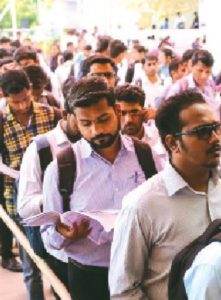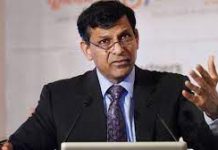 Indian economy is in a vicious circle of slowdown. The symptoms of deteriorating health of the economy started appearing during FY 2018-19 when statistics on low employment rate, lay-offs in leading corporate houses and rising non-performing assets of banks came to the fore. But the claims and concerns of industry and think-tanks about a deep demand deficit in the economy got fortified when the Reserve Bank of India officially announced a downward revision of GDP for FY 2020.
Indian economy is in a vicious circle of slowdown. The symptoms of deteriorating health of the economy started appearing during FY 2018-19 when statistics on low employment rate, lay-offs in leading corporate houses and rising non-performing assets of banks came to the fore. But the claims and concerns of industry and think-tanks about a deep demand deficit in the economy got fortified when the Reserve Bank of India officially announced a downward revision of GDP for FY 2020.
The confirmation of the widespread economic deceleration in the wake of downward revision of GDP (Gross Domestic product) forecast to 6.1 per cent from the earlier 6.9 per cent in first week of October by the Reserve Bank of India raised the red flag for an impending economic predicament.
The dismay was further reinforced when the International Monetary Fund Chief, Kristalina Georgieva was profusely quoted by the media saying, “The global economy is witnessing “synchronized slowdown”, which will result in slower growth for 90 per cent of the world this year, and the effect is even “more pronounced” in some of the largest emerging market economies like India.”
The target of propelling Indian economy on the fast-track growth and upgrade the economy at US $5 trillion by 2024 from the current US$2.8 billion seems unachievable with the current growth projections. The observation by the IMF chief, based on the report ‘World Economic Outlook’that has been recently released; stirred up a hornet’s nest of economic thinkers and experts.
Of late, Moody’s Investor Services has also cut down the GDP forecast for India to 5.8 per cent from earlier 6.2 per cent.
Government’s obsession with the low inflation is one of the major causes of tepid economic growth, is believed by some of the economists.
For a 5 trillion economy, the nominal growth rate should be close to 10-12 per cent till 2024. A 6 per cent growth rate cannot drive up the economy from the current size of $2.8 trillion to $5 trillion by 2024. While the GDP growth rate in the first two quarters has remained low, the policymakers are banking on better growth performance in the next two quarters. The demand is expected to rise during the festival season and the financial stimulus pumped in the economy is projected to bear fruits with a time lag, and accordingly boost demand in the first few months of 2020 calendar year.
Forlorn labour market and demand deficit
The failure of government in creating jobs has severely affected the demand side and the widening gap between demand and supply is the major cause of decelerated economic growth.
India is losing its demographic dividend due to sluggish demand, liquidity crunch, subdued investments and finally, the tight job market. The high unemployment rate which some reports have quoted to be the highest in last 45 years is not a good signal for a growing economy like India. According to Centre for Monitoring Indian Economy, The year-on-year employment growth in rural India was clocked at 2.9 per cent in August 2019 and at the same time urban India registered a 0.2 per cent decline. The rural unemployment rate was calculated to be 7.8 per cent and urban at 9.6 per cent during August 2019.
The labour market is still recovering from the shock of demonetization and GST (Goods and Services Tax) that led to a rise in unemployment rate in India, says CMIE’s report.
Nearly two-thirds of Indians are of working age but an increasing number of them are struggling to find suitable employment. Though many, who are under-employed and disguisedly employed in agriculture are mostly excluded in the methodology adopted to study unemployment. If that is included, the statistics could be scary.
In the present situation a combination of demand side and cost side factors is interplaying to aggravate the slowdown in Indian economy.
As we see that corporate sector is facing glut in production, it has an impact on ancillaries- mostly run as SMEs which are huge employment generators. This has an impact on demand for credit and service of debt. Despite best efforts of cost cutting, through lay-offs and other measures many units have become NPAs (Non-Performing Assets) putting our financial sector under stress.
Sensing the gravity of situation, Finance Minister Nirmala Sitharaman announced a roll-back of corporate tax from 30 per cent to 22 per cent. After an initial roar and applaud, the firms and industrial outfits evaluated that it is only a supply side solution. The government has not been able to diagnose the problem with a clear approach. The demand side incentives like reduction in indirect tax would help to fuel up the demand.
The Finance Minister also announced an upfront capital infusion of 70,000 crore into government owned banks in order to boost lending and improving liquidity situation. It is projected by the finance ministry that an additional liquidity to the tune of 5 lakh crore through multiplier-effect and help restore the pace of economic growth.
The rollback of enhanced surcharge on foreign portfolio investors (long and short-term capital gains arising from transfer of equity) levied in the budget is also an effort to revive the sentiments of investors to infuse fresh investments.
Ailing automobiles
The automobile sector, one of the major employers in the organised business has been severely hit by the cyclic downturn in demand. The industry was expecting a cut in GST on passenger and commercial vehicles from the prevailing 28 per cent to 18 per cent to spur the demand through price reduction. But the policy makers did not take cognizance of the demand of manufacturers. Nevertheless, the FM deferred the decision to hike the one-time registration fee on vehicles till June 2020. Some other decisions like lifting of ban on purchase of vehicles by government departments and registration of both electrical and internal combustion vehicles are yet to fetch results.
In the light of sharp decline in the sales of major automobile players in India the Government’s incentives is less for the one who needs more. The quarterly financial results of the market leaders exhibit that the sector is in doldrums. The prominent players in this segment- Maruti Suzuki India, Tata Motors, Mahindra and Mahindra and Honda reported a substantial decline in their sales in the last quarter.
The drop in sales for these manufacturers is reported to be 20 per cent to 58 per cent for different segments. Despite the high discounts offered by the manufacturers the auto-sector continues to witness high de-growth.
According to the top managements of these companies, they expect a revival in demand as the Finance Minister Nirmala Sitharaman has announced various measures to spur the demand. Albiet, the floods in different parts of the country undermined the demand in the month of August and unfavourable rate of exchange is adversely affecting the cost.
Former prime Minister and noted economist Dr. Manmohan Singh recently commented on the downturn in Indian economy. Otherwise reticent Singh elaborated on the causes and remedies for reviving the economic growth. For a 5 trillion economy, the nominal growth rate should be close to 10-12 per cent till 2024. A 6 per cent growth rate cannot drive up the economy from the current size of $2.8 trillion to $5 trillion by 2024.
Agricultural distress
Any discussion on Indian economy, without mentioning the performance and problems of agriculture sector is unaccomplished. A sector that provides livelihood to more than half of country’s population is in a severe jeopardy.
To a large extent, it is a neglect of the agriculture sector that is responsible for the drying up of aggregate demand. The half-hearted efforts of successive governments over the years, have created such forces in the rural economy those act and react on each other and trapped the rural unskilled labour of our country in poverty and backwardness for generations.
The growth rate of agriculture and allied activities in the third quarter of 2018-19 (October-December) was registered at 2.7 per cent against 4.6 per cent in the corresponding period during the last year. The annual growth rate in agriculture and allied activities was estimated at 2.7 per cent. This was huge slide from 5 per cent in 2017-18.
In no other country of the world, such large number of productive workforce is employed, more appropriately put as underemployed and disguised employed in agriculture. Over the years, the contribution of agriculture to Gross Domestic Product of our country has shrunk from 56.5 per cent in 1950-51 to 51.7 per cent in to 15.7 per cent in 2009-10. Thus 58.2 per cent workforce in our country contributes only 51.7 per cent to the country’s gross domestic product. This indicates an alarmingly low per capita income from farm sector and at the same time a wide gap between farm and non-farm income.
Another noticeable trend in agriculture is that the proportion of cultivators in the rural population is on a declining mode whereas the proportion of agriculture labourers is on a rise.
The slowdown is generally seen from the lens of manufacturing sector but the beginning of the demand slowdown starts from rural India. With a broad base of demand which is close to 50 per cent of the market size, India cannot afford to ignore the stagnation in agriculture. Falling returns in agriculture and consequent rising debts of the farmers disrupt the income circle in the economy.
During the post reform period (Economic reforms of 1991) the disinvestments by the government sector have not been equated by a requisite amount of private investment. A sustainable model of job creation has evaded the Indian economy. Even government’s own studies reveal (NSSO survey) that a large section of farming community is wary of agriculture as an occupation and wishes to quit agriculture. The NSSO study (2003), reported that 40 per cent of Indian farmers expressed their desire to leave farming. The absence of alternative employment is the reason behind sticking to agriculture, albeit unviable for them.
The initiative of government offering financial assistance to rural households by offering an annual grant of 6000 per households has failed to firm up the demand or at least, there are no clear signals of revival of rural demand. Post the agricultural debt waivers (offered in states of Maharahtra, Uttar Pradesh, Punjab, Telengana among others to mitigate rural distress) the rural economy has not exhibited any encouraging signs. The infusion of funds through MNREGA (Mahatma Gandhi National Rural Employment Guarantee Act) and other welfare schemes have guzzled the funds without much outcome. The Moody’d Investor Services recent report has also argued that the slowdown in the consumption is driven by the financial stress among rural households and weak job creation.
The problems of agriculture sector are umpteen. The farm incomes suffer due to volatility in the prices of commodities. These fluctuations are Achilles heel for the farmers. In order to keep inflation under watch, the rising prices of commodities are controlled by the government. On the other hand, in wake of a price rise, for instance, in case of onion and pulses, we resort to imports. The farming community perceives a bias of the government towards the urban middle class at the cost of illiterate and poor farmers.
The 70th round of NSSO survey
reported that average monthly agriculture income per household from various sources is 6,426. Here, the question arises is if half of the country’s population is thriving on a monthly consumption expenditure of 6,426 can we become a US $ 5 trillion economy by 2024?
Muddled financial sector
Another pillar of our economy, the financial sector of the country is grappling with liquidity crunch and piling non-performing assets. The collapse of non-banking and banking institutions in the recent pass has given a big jolt to the economy.
The economy already reeling under slowdown sunk into banking quagmire with bank after bank reporting colossal amount of losses due to scandalous transactions. Recent frauds in the banking sector that include Punjab National Bank, IL&FS,IDBI Bank, Laxmi Villas Bank and very recent Punjab and Maharashtra Cooperative Bank has pushed the economy into deeper catastrophe.
The Annual Report of Reserve Bank of India examines the frauds worth 71,000 cr for the financial year 2018-19. This is not the end of the story as the fresh frauds are unfolding with PMC scam reported recently. The total proceeds of crime involved are estimated to be 4,355 crore. The retail depositors stare at uncertain future as money is stuck for over a month.
A close scrutiny of banking frauds reveals a huge laxity on the part of bank officials and monitoring agencies. The requisite due diligence is not done by the concerned officials and RBI in most of the cases is unable to detect the fraud through its own investigation. The misutilization of funds by the banks and NBFCs comes to light only when they voluntary disclose it after keeping it under carpet for long.
The financial scams have exposed the clandestine understand of the authorities and the fraudsters because CBS (Core Banking Solutions) technology provides a complete transparency in the borrowing and lending and leaves no room for discrepancy. In the case of PMC Bank it has been revealed that the many transactions were not uploaded in the CBS and RBI could not track the corruption in the urban cooperative bank.
According to the RBI Report, small frauds of amount less than Rs one lakh were just 0.1 per cent of the amounts involved.
The amount siphoned off and drained out by the large borrowers could have saved hundreds of SME (small and medium industry) clusters scattered across India who are grappling with working capital requirement. The investment in micro, small and medium industry can prove to be a big demand driver and employment generator.
The unused army of workforce in rural areas can be absorbed in SMEs with resorting to urban migration. The SME clusters are generally located in suburbs due to viable land cost , thus utilise the redundant semi-skilled man-power with costing much for their rehabilitation.
According to Raghuram Rajan, former RBI Governor and a noted economist, “ill-conceived demonetization and the poorly executed GST roll out” are the two key reasons for the current slowdown. These two perceived game-changers hit the fragile economy with very bad consequences. The excessive centralization of power in political decision-making is also factor behind the economic calamity, the country is exposed to.
Capital market
The Annual Report of RBI (August 2019) provides insights into ailing capital and money markest, this is a significant indicator of sliding faith of investors and bleak investment prospects. The report says, “The primary segment of the equity market exhibited lacklustre activity during 2018-19. Resource mobilisation through public and rights issues was higher in the first five months of 2018-19 on a y-o-y basis; however, it moderated substantially from September 2018 onwards on account of heightened uncertainty and volatile secondary market conditions. Resource mobilisation through initial public offers (IPOs) and rights issues declined by 82.7 per cent to 182.4 billion during 2018-19. Companies mobilised a total of 160.9 billion through 123 IPO issues, out of which 110 issues amounting to 18.4 billion were listed on the small and medium enterprises (SME) platform of the BSE and the NSE. Resource mobilisation through qualified institutional placement (QIP) declined sharply to 102.9 billion in 2018-19 from 672.4 billion in 2017-18.”
According to this report, Net resource mobilisation by MFs declined by 59.6 per cent to 1,097 billion in 2018-19. Resource mobilisation through equity-oriented schemes declined to 1,080 billion in 2018-19 from 1,711 billion in 2017-18, mainly on account of lower investments by individuals and corporates during 2018-19 than a year ago.
Primary market resource mobilisation through public and rights issues of equity increased significantly by more than eight times (y-o-y) during Q1:2019-20 on account of higher resource mobilisation by telecom companies through rights issues. QIP issues declined by 16.3 per cent during Q1:2019-20. The net resources mobilised by MFs declined significantly by 86.8 per cent during Q1:2019-20 primarily due to decline in net inflows in money market MFs.
Where does the solution lie
An evaluation of different sectors of the economy explains that a constellation of different factors are interplaying with each other to make the slowdown deeper. There is a discourse going on among the experts on whether this slowdown is cyclical or structural. For the time being it is assumed to be cyclical; hoping that simultaneous interventions by the government on demand and supply will pull the economy from mare’s nest.
The Government needs to fire on all cylinders to rescue the economy from the worsening economic growth. With clear warning bells from international and national agencies, it is time to channelize the resources where maximum returns can be accrued in minimum time period. A quote by Albert Einstein “The significant problems we face cannot be solved at the same level of thinking we used when we created them” fits the current situation.
letters@tehelka.com













